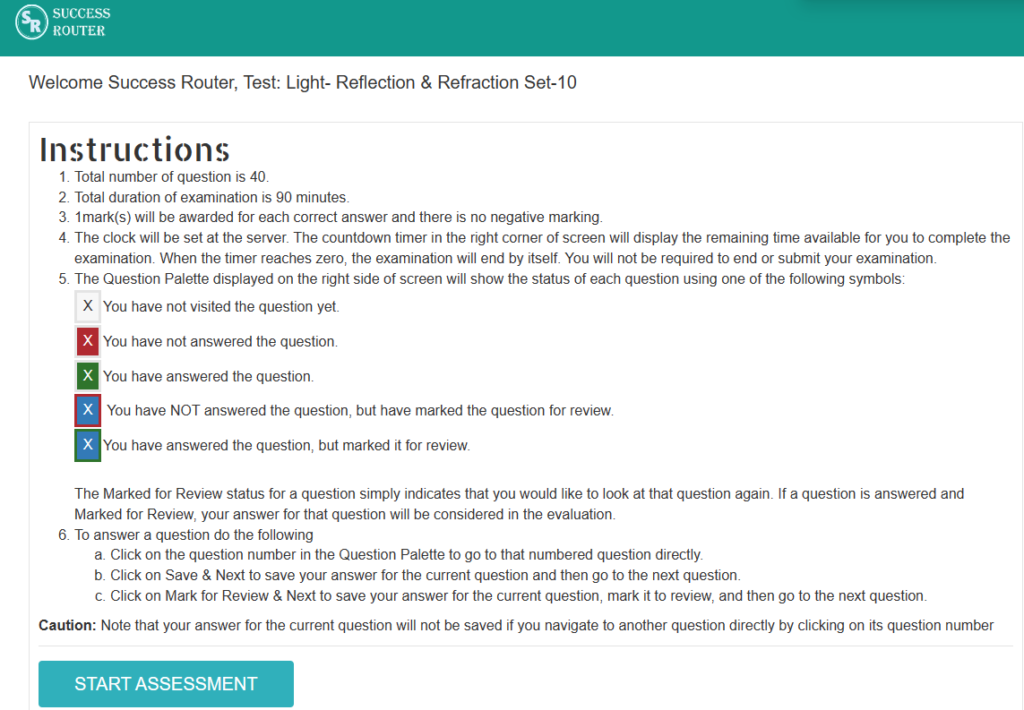Last Updated on August 26, 2024 by XAM CONTENT
Hello students, we are providing assertion and reason questions for class 10 science. Assertion reason questions are the new question format that is introduced in CBSE board. The resources for assertion reason questions are very less. So, to help students we have created chapterwise assertion reason questions for class 10 science. In this article, you will find assertion reason questions for CBSE Class 10 Science Chapter 10 Human Eye and Colourful World.
| Chapter | Human Eye and Colourful World |
| Type of Questions | Assertion Reason Questions |
| Nature of Questions | Competency Based Questions |
| Board | CBSE |
| Class | 10 |
| Subject | Science |
| Unit | Unit 3 Natural Phenomena |
| Useful for | Class 10 Studying Students |
| Answers provided | Yes |
| Difficulty level | Mentioned |
| Important Link | Class 10 Science Chapterwise Assertion Reason |
Assertion Reason Questions on Human Eye and Colourful World
Directions:
(a) Both A and R are true and R is correct explanation of the assertion.
(b) Both A and R are true but R is not the correct explanation of the assertion.
(c) A is true but R is false.
(d) A is false but R is true.
Q. 1. Assertion (A): Ciliary muscles help in changing the focal length of the eye lens.
Reason (R): Ciliary muscles help to focus near and distant objects in quick succession.
Difficulty Level: Medium
Ans. (b) Both Assertion (A) and Reason (R) are true but Reason (R) is not the correct explanation of Assertion (A).
Q. 2. Assertion (A): A person suffering from myopia cannot see the distant objects clearly.
Reason (R): A converging lens is used for the correction of myopic eye as it can form real as well as virtual images of the objects placed in front of it.
Ans. (c) Reason (R) is false because a diverging lens or concave lens is used for the correction of myopic eye.
Q. 3. Assertion (A): The white light is dispersed into seven constituent colours when passed through the prism.
Reason (R): Different colours of light bend through different angles as they pass through a prism.
Ans. (a) Both Assertion (A) and Reason (R) are true and Reason (R) is the correct explanation of Assertion (A).
Q. 4. Assertion (A): The planets twinkle while the Stars do not.
Reason (R): The planets are much closer to the Earth than the Stars.
Ans. (d) Assertion (A) is false because planets do not twinkle while stars twinkle.
Q. 5. Assertion (A): The rainbow is seen when the Sun is behind the observer.
Reason (R): Rainbow is produced due to dispersion of white light by small rain drops hanging in the air after the rain.
Ans. (b) Both Assertion (A) and Reason (R) are true but Reason (R) is not the correct explanation of Assertion (A).
Explanation: Just after the rain, a large number of small droplets of water remain suspended in the air. Each drop acts like a small prism. When sunlight fall on these drops the white light splits into seven colours. The dispersed light from a large number of drops forms a continuous band of seven colours.
Also check
- Chemical Reactions and Equations Class 10 Assertion Reason Questions Science Chapter 1
- Human Eye and Colourful World Class 10 Assertion Reason Questions Science Chapter 10
- Life Processes Class 10 Assertion Reason Questions Science Chapter 6
- Light – Reflection and Refraction Class 10 Assertion Reason Questions Science Chapter 10
You may also like
Download eBooks for CBSE Class 10 Science Human Eye and Colourful World
- Human Eye and Colourful World Important Questions for CBSE Class 10 Science
- Human Eye and Colourful World Chapter Test
Helpful Links for CBSE Class 10 Science Preparation
- Download 125 Important Case Study Questions for CBSE Class 10 Science
- Download 220 Important Assertion Reason Questions for CBSE Class 10 Science
- Download 225 Practical Based Questions for CBSE Class 10 Science
- Download 65 Important Numerical Problems for CBSE Class 10 Physics
- Download 60 Important Diagram Based Questions for CBSE Class 10 Physics
- Download 150 Most Repeated Questions for CBSE Class 10 Science
- Download Chapter Test for CBSE Class 10 Science
Topics from which assertion reason questions may be asked
- Functioning of a lens in human eye
- Defects of vision and their corrections
- Applications of spherical mirrors and lenses.
- Refraction of light through a prism
- Dispersion of light
- Scattering of light
- Applications in daily life (excluding colour of the sun at sunrise and sunset).
You are going to study the above topics in class 10 Human Eye and Colourful World chapter. So, assertion reason questions based on above topics may be asked.
We hope the given Assertion and Reason Questions for Human Eye and Colourful World Class 10 Science helps you in your learning.
Quiz
| Topic | Human Eye and Colourful World |
| Useful for | CBSE Class 10 Students |
| Type of Questions | MCQs |
| No. of Questions | 50 |
| Solutions | Instant Solutions after Completion of Quiz |
| Quiz Link | Click here to Take Test |
| Price | Free |
How to take quiz or test using the given link
It’s quite simple!
Step 1: Click on the given link. You will see the below screen.

Step 2: Fill in the necessary details. There is no need to register. Just fill your email and name and click on the button “Take Assessment”. The below screen will appear.

Step 3: Click on start assessment. Now you are ready to take test.

Frequently Asked Questions (FAQs) on Human Eye and Colourful World Assertion Reason Questions
Q1: What are assertion reason questions?
A1: Assertion-reason questions consist of two statements: an assertion (A) and a reason (R). The task is to determine the correctness of both statements and the relationship between them. The options usually include:
(i) Both A and R are true, and R is the correct explanation of A.
(ii) Both A and R are true, but R is not the correct explanation of A.
(iii) A is true, but R is false.
(iv) A is false, but R is true. or A is false, and R is also false.
Q2: What strategies should students use to answer assertion reason questions effectively?
A2: Students can use the following strategies:
Understand Each Statement Separately: Determine if each statement is true or false independently.
Analyze the Relationship: If both statements are true, check if the reason correctly explains the assertion.
Q3: What are common mistakes to avoid when answering Assertion Reason questions?
A3: Common mistakes include:
Not reading the statements carefully and missing key details.
Assuming the Reason explains the Assertion without checking the logical connection.
Confusing the order or relationship between the statements.
Overthinking and adding information not provided in the question.
Q4: How can practicing assertion reason questions help students?
A4: Practicing assertion-reason questions can help students in several ways:
Improved Conceptual Understanding: It helps students to better understand the concepts by linking assertions with their reasons.
Enhanced Analytical Skills: It enhances analytical skills as students need to critically analyze the statements and their relationships.
Better Exam Preparation: These questions are asked in exams, and practicing them can improve your performance.
Q5: Name the type of particles which act as prisms in the formation of rainbow in the sky.
A5: The tiny water droplets present in the atmosphere act like small prisms.
Q6: Name the phenomenon responsible for apparent flattening of the Sun’s disc at sunrise and sunset.
A6: The apparent flattening of the Sun’s disc at sunrise and sunset is due to atmospheric refraction.
Q7: Which phenomenon is responsible for making the path of light visible?
A7: Tyndall effect makes the path of light visible.
Q8: Is the position of a star as seen by us is its true position? Justify your answer.
A8: No, due to atmospheric refraction a star appears to be slightly higher than its actual position.
Q9: How is the sense of vision carried from the eye to the brain?
A9: The sense of vision is carried from the eye to the brain through optic nerve.
Q10: What is the range of vision for a normal human eye?
A10: For a normal human eye, the range of vision is from 25 cm to infinity.
Q11: What is meant by far point of the eye?
A11: The farthest point up to which the eye can see objects clearly is called the far point of the eye. It is infinity for a normal eye.
Q12: Why is a normal eye not able to see clearly the objects placed closer than 25 cm?
A12: A normal eye is unable to see the objects placed closer than 25 cm because the focal length of the eye lens cannot be decreased below a certain minimum limit.
Q13: Are there any online resources or tools available for practicing life processes assertion reason questions?
A13: We provide assertion reason questions for CBSE Class 10 Science on our website. Students can visit the website and practice sufficient assertion reason questions and prepare for their exams. If you need more assertion reason questions, then you can visit Physics Gurukul website. they are having a large collection of assertion reason questions for all classes.


